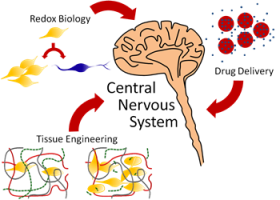Research
The Lampe Group’s research interests are neural tissue engineering, biomaterials, drug delivery, redox regulation of stem cell fate, engineering cell-interactive microenvironments, computational approaches to designing extracellular matrix mimetics
Research Overview
Neural regeneration within the central nervous system (CNS) is a critical unmet challenge as CNS disorders continue to be the leading cause of disability nationwide. Many novel drug delivery and 3-dimensional tissue engineering strategies present innovative therapeutic approaches, but still require substantial research into cell-biomaterial interactions before they can be effectively translated to the clinic. Engineers can provide a unique perspective in the design and development of materials for human health.
Our research is an innovative combination of in vitro systems and future in vivo applications of biomaterial-stem cell interactions drawing on aspects of engineering, stem cell biology, and neuroscience with a unifying theme of functional neural tissue engineering. Our overarching goal is to develop a new, integrated approach in building material systems that are both cell-instructive and cell-responsive, creating a dynamic feedback loop between a cell and its engineered microenvironment.
Our multidisciplinary lab focuses on biomaterial and drug delivery applications for neurodegenerative diseases and injuries of the CNS and investigate material effects on cell behaviors such as proliferation, differentiation, directed neurite growth, and tissue function.
Current Projects
Interactive 3D culture materials that support neural maturation and axon myelination
We are identifying conditions suitable for differentiation of NSCs and oligodendrocyte precursor cells (OPCs) into mature oligodendrocytes.
Tailored drug delivery within the central nervous system via passive and active mechanisms
We aim to accomplish CNS drug delivery via injectable materials that can easily pass through a small diameter needle and be retained at the site of injection until full biodegradation.
Redox regulation of stem cell self-renewal and differentiation
We are harnessing the power of degradable materials to elucidate novel understandings of oxidant and antioxidant effects of biomaterials on cells, manipulate the redox balance of encapsulated cells, and positively bias cell fate...
Computational approaches to designing extracellular matrix mimetics
Using classical, all-atom MD simulations we have examined the molecular behavior of our LG-ELP design (Figure a & b) near its putative phase transition, as well as the temperature-dependent conformational and structural dynamics leading up to the LCST.
